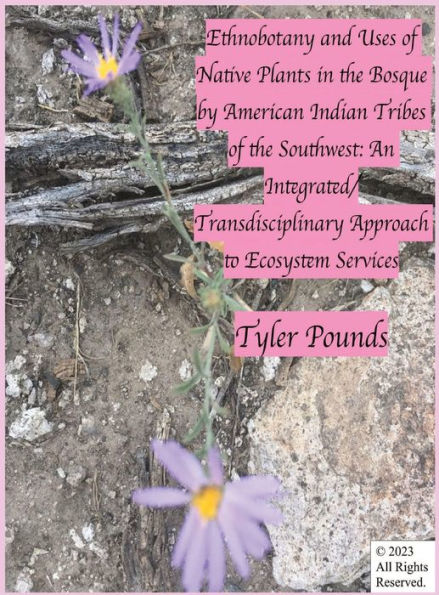All Rights Reserved
Copyright Registration Number / Date: TX0009300836 / 2023-07-27
Library of Congress Control Number: 2023911516
The First Book for Mr. Tyler Pounds "Integrated Human-Nature Relations". The "School of Integrated Human-Nature Relations" combines the fields of Anthropology, Wildlife Biology (Botany, Ecology, Zoology) into a cohesive integrated format. The school (and thus this book) delves into the direct links and relationships that humans have with nature. Exploring the direct links and relationships that humans have with nature is a critical first step on solving the worlds "biodiversity crisis". This book uses the fields of Ecological Anthropology, Ethnobotany, Integrated Biology to showcase biodiversity on Native American reservations as well as showcasing how Ethnographic Field Methods can be integrated and used for wildlife management through an "Ecosystem Service" lens. The showcasing of ecological data sets on Native American reservations is critical in proving to the world just how important and invaluable Traditional Ecological Knowledge (TEK) Systems are in conserving the worlds biodiversity. Integrating and "bridging of the sciences" will be crucial in solving the worlds biodiversity and global climate change crisis. We now stand in the "Anthropocene Epoch" of human caused ecological destruction. To value nature is to value one's own self and well-being.
1144888365
Copyright Registration Number / Date: TX0009300836 / 2023-07-27
Library of Congress Control Number: 2023911516
The First Book for Mr. Tyler Pounds "Integrated Human-Nature Relations". The "School of Integrated Human-Nature Relations" combines the fields of Anthropology, Wildlife Biology (Botany, Ecology, Zoology) into a cohesive integrated format. The school (and thus this book) delves into the direct links and relationships that humans have with nature. Exploring the direct links and relationships that humans have with nature is a critical first step on solving the worlds "biodiversity crisis". This book uses the fields of Ecological Anthropology, Ethnobotany, Integrated Biology to showcase biodiversity on Native American reservations as well as showcasing how Ethnographic Field Methods can be integrated and used for wildlife management through an "Ecosystem Service" lens. The showcasing of ecological data sets on Native American reservations is critical in proving to the world just how important and invaluable Traditional Ecological Knowledge (TEK) Systems are in conserving the worlds biodiversity. Integrating and "bridging of the sciences" will be crucial in solving the worlds biodiversity and global climate change crisis. We now stand in the "Anthropocene Epoch" of human caused ecological destruction. To value nature is to value one's own self and well-being.
Ethnobotany and Uses of Native Plants in the Bosque by American Indian Tribes of the Southwest: An Integrated/Transdisciplinary Approach to Ecosystem Services
All Rights Reserved
Copyright Registration Number / Date: TX0009300836 / 2023-07-27
Library of Congress Control Number: 2023911516
The First Book for Mr. Tyler Pounds "Integrated Human-Nature Relations". The "School of Integrated Human-Nature Relations" combines the fields of Anthropology, Wildlife Biology (Botany, Ecology, Zoology) into a cohesive integrated format. The school (and thus this book) delves into the direct links and relationships that humans have with nature. Exploring the direct links and relationships that humans have with nature is a critical first step on solving the worlds "biodiversity crisis". This book uses the fields of Ecological Anthropology, Ethnobotany, Integrated Biology to showcase biodiversity on Native American reservations as well as showcasing how Ethnographic Field Methods can be integrated and used for wildlife management through an "Ecosystem Service" lens. The showcasing of ecological data sets on Native American reservations is critical in proving to the world just how important and invaluable Traditional Ecological Knowledge (TEK) Systems are in conserving the worlds biodiversity. Integrating and "bridging of the sciences" will be crucial in solving the worlds biodiversity and global climate change crisis. We now stand in the "Anthropocene Epoch" of human caused ecological destruction. To value nature is to value one's own self and well-being.
Copyright Registration Number / Date: TX0009300836 / 2023-07-27
Library of Congress Control Number: 2023911516
The First Book for Mr. Tyler Pounds "Integrated Human-Nature Relations". The "School of Integrated Human-Nature Relations" combines the fields of Anthropology, Wildlife Biology (Botany, Ecology, Zoology) into a cohesive integrated format. The school (and thus this book) delves into the direct links and relationships that humans have with nature. Exploring the direct links and relationships that humans have with nature is a critical first step on solving the worlds "biodiversity crisis". This book uses the fields of Ecological Anthropology, Ethnobotany, Integrated Biology to showcase biodiversity on Native American reservations as well as showcasing how Ethnographic Field Methods can be integrated and used for wildlife management through an "Ecosystem Service" lens. The showcasing of ecological data sets on Native American reservations is critical in proving to the world just how important and invaluable Traditional Ecological Knowledge (TEK) Systems are in conserving the worlds biodiversity. Integrating and "bridging of the sciences" will be crucial in solving the worlds biodiversity and global climate change crisis. We now stand in the "Anthropocene Epoch" of human caused ecological destruction. To value nature is to value one's own self and well-being.
78.99
In Stock
5
1

Ethnobotany and Uses of Native Plants in the Bosque by American Indian Tribes of the Southwest: An Integrated/Transdisciplinary Approach to Ecosystem Services
158
Ethnobotany and Uses of Native Plants in the Bosque by American Indian Tribes of the Southwest: An Integrated/Transdisciplinary Approach to Ecosystem Services
158Hardcover(Large Print)
$78.99
78.99
In Stock

Product Details
| ISBN-13: | 9798869237767 |
|---|---|
| Publisher: | Tyler Pounds-Self Published |
| Publication date: | 07/05/2023 |
| Series: | Integrated Human-Nature Relations , #1 |
| Edition description: | Large Print |
| Pages: | 158 |
| Product dimensions: | 8.50(w) x 11.00(h) x 0.56(d) |
About the Author
From the B&N Reads Blog
